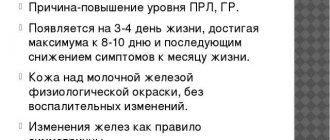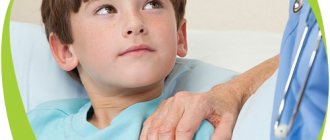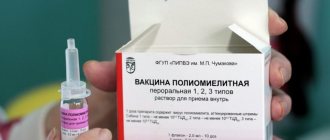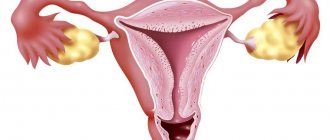About the disease
Pancreatitis is a common pathology of the gastrointestinal tract (GIT), which is accompanied by local inflammation of the pancreatic tissue and its ducts.
The organ in question plays a key role in the digestion process, ensuring the release of large amounts of enzymes into the intestines. The pancreas is also involved in controlling blood glucose levels through the secretion of insulin. Pancreatitis leads to disruption of these functions, which can cause a serious deterioration in the child’s condition. The disease occurs acutely or chronically. In children, it is important to recognize the pathology as quickly as possible in order to prescribe adequate treatment in a timely manner. Otherwise, the disease progresses and leads to organic damage to the gland tissue and an increased risk of developing serious complications - diabetes mellitus, severe digestive disorders, collapsed reactions (fainting and loss of consciousness).
Classification
Childhood pancreatitis can manifest itself in acute or chronic form (each type has its own characteristics of symptoms and differs in the degree of damage to the digestive tract). Based on the nature of changes in the tissues of the gland, purulent, acute edematous, hemorrhagic and fatty pancreatic necrosis are distinguished. This classification is carried out taking into account the complications of the disease. Depending on the speed of development, DP can be latent or recurrent.
Classification according to origin:
- hereditary type (autosomal domain transmission);
- secondary form (against the background of inflammatory processes in other organs);
- primary type (manifests as an attack of acute pancreatitis).
Symptoms of pancreatitis
Pancreatitis is a disease that in 90% of cases is accompanied by a violation of the secretion of digestive enzymes by the gland. The result of such a lesion is a deterioration in the functioning of the child’s gastrointestinal tract with the appearance of characteristic symptoms. The most common signs of pancreatitis in children are:
- pain in the abdomen - the discomfort is girdling in nature and radiates to the back;
- flatulence;
- violation of bowel movements such as diarrhea;
- loss of appetite;
- nausea, vomiting;
- increase in body temperature to 37-38°C.
In infants and newborns, the symptoms of pancreatitis are less severe than in children of the older age group.
Sometimes parents may not even notice any special changes in the baby’s behavior. In adolescents, the symptoms of the disease differ in brightness and intensity. This is due to the influence of a significant number of provoking factors. The clinical picture of the disease depends on the form and duration of the pathological process, as well as the degree of damage to the pancreas. With chronic inflammation, the pain can be of a protracted, aching nature. At the same time, the child loses body weight, the condition of the skin, nails, and hair worsens.
If any of these signs are detected, parents should seek help from a doctor. Early diagnosis of pancreatitis with the prescription of adequate treatment helps to quickly stabilize the baby’s digestive function and minimize the risk of complications.
Causes of pancreatitis
The pathogenetic basis of pancreatitis of any origin is local inflammation of the gland tissue.
The key mechanism of this pathological process is the release of excessive amounts of active enzymes, which begin to damage the organ's own structures. Hyperactivation of the secretory function of the gland can be either primary or secondary (develops as a result of pathology of other organs and systems). In newborns and infants, pancreatitis most often occurs as a result of congenital anomalies in the development of the organ and its ducts. Due to the lack of adequate outflow, enzymes accumulate inside the gland and trigger the process of lysis (chemical destruction) of its own tissues.
In school-age children and teenagers, activation of the secretion of bioactive enzymes can be triggered by the following factors:
- eating large amounts of fried and fatty foods - the child’s digestive tract is not suitable for digesting “heavy” foods;
- viral or bacterial lesions of the gastrointestinal tract with penetration of the pathogen into the pancreas;
- narrowing of pancreatic ductuses against the background of neoplastic processes in the abdominal cavity.
The risk of developing pancreatitis also increases with irregular nutrition, consumption of large amounts of fast food, and carbonated drinks. Damage to the pancreas sometimes occurs due to the use of aggressive medications or the entry of toxins into the baby’s gastrointestinal tract.
Diagnosis of pancreatitis
Gastroenterologists and pediatricians at SM-Doctor are specialists with experience of 10 years or more. Thanks to the extensive experience and modern equipment that our clinic is equipped with, doctors can quickly identify pancreatitis even in the early stages of development. All this creates optimal conditions for prescribing adequate treatment and, consequently, restoring the child’s condition in the shortest possible time. The doctor makes a preliminary diagnosis of pancreatitis at the first consultation. Anamnesis of the disease and features of the clinical picture help him with this. To verify the diagnosis, the following additional studies are prescribed:
- general clinical analysis of blood and urine;
- biochemical blood test - special attention is paid to the level of alpha-amylase;
- ultrasound scanning (ultrasound) of the abdominal organs;
- stool test for elastase-1;
- CT, MRI of the abdominal cavity (if necessary in complex clinical cases).
If there is a suspicion of concomitant dysfunction of other internal organs and systems, the gastrologist refers the child for consultation to related specialists (infectious disease specialist, neurologist, nephrologist).
04/30/2020 Prevention and basic nutrition for pancreatitis in a child
Pancreatitis is a complex disease, the consequences of which can be very serious. It requires long-term treatment and constant diet maintenance. A healthy lifestyle, proper nutrition, a good emotional atmosphere in the family and attention to changes in the state of the child’s body will help cope with this disease and prevent exacerbation of the pathology.
The basis for the prevention of pancreatitis in children is the creation of ideal living conditions. A balanced diet, daily routine, regular exercise, lack of stress, hardening, prevention and timely treatment of infections and other diseases of the gastrointestinal tract will minimize the possibility of pancreatitis.
If the disease has already made itself felt, then you should pay attention to the child’s nutrition. The exclusion of fatty, fried, and spicy foods is a necessary factor in the prevention of the disease. You should also limit the amount of food you eat at one meal. When the first signs of exacerbation of the disease appear, it is necessary to immediately switch to dietary nutrition to prevent its further development.
Observation by a gastroenterologist is mandatory; children with chronic pancreatitis are not deregistered until they are transferred to an adult network. If a child has so-called reactive pancreatitis, recurrent pancreatitis, then the patient is observed for 5 years after the last relapse. If during this period of time there were no exacerbations of the disease, there are no changes on ultrasound of the abdominal organs, and laboratory parameters are within normal limits, then the issue of removal from the dispensary register or continued observation is decided.
Now let's talk about the basics of nutrition. Vegetarian soups can include potatoes, carrots, buckwheat and oatmeal, and vermicelli. It is acceptable to eat lean meats and fish. It can be lean beef, chicken, turkey, rabbit, hake, navaga, pollock, pike perch, bream. The daily intake of dairy products is 200 g. Low-fat milk, cottage cheese, and cheese can be consumed both in their pure form and in the form of casseroles and soufflés. Eggs can be boiled or scrambled, but no more than 1 egg per day. Porridges of various varieties, cooked in milk, and boiled vegetables will complement the daily diet. Ripe non-acidic fruits and berries are allowed after heat treatment; they serve as a source of fiber, vitamins and minerals. You will have to give up coffee, cocoa, and carbonated drinks. Allowed are weak tea with lemon and a small amount of sugar, non-acidic fruit and berry juices - preferably half and half with water and only after a meal - during the period of remission. Strict adherence to the diet will help improve the quality of life and avoid exacerbations of the disease. Therefore, even with long-term remission and good health, you should not violate your diet and diet.
For the treatment of pancreatitis in children, dietary nutrition according to Pevzner 5p is indicated; when stable remission is achieved, you can switch to table number 5. It is advisable to cook food for patients in a double boiler, you can boil it. Strictly prohibited are foods that promote flatulence and stimulate the secretion of digestive juices - fried, fatty foods, very cold or hot foods and drinks. Smoked meats, marinades, mushrooms, ketchups, mayonnaise, spices, onions, garlic, radishes, sorrel are not recommended, vegetable oil and butter are limited - only in dishes. Products containing xenobiotics are excluded, i.e. substances foreign to the body: preservatives, dyes, leavening agents, flavor enhancers, etc. Food intake is carried out 5-6 times a day in small portions. You should not eat at night, before going to bed.
Dietary nutrition is most effective in combination with other therapeutic and health-improving factors: a healthy lifestyle, adequate sleep, adequate physical activity, exercise therapy, personal hygiene, the use of mineral waters (Lipetskaya, Slavyanovskaya, Borjomi, Smirnovskaya, Essentuki-4). An anti-relapse course of treatment to prevent exacerbations of the disease can be carried out in a sanatorium-resort setting.
Chief pediatric gastroenterology specialist
UZO Lipetsk region, candidate of medical sciences - O.N. Puchnina
Treatment of pancreatitis
The key aspect of the treatment of pancreatitis is to ensure the maximum possible functional rest of the gland in the acute phase of inflammation.
A significant decrease in the secretory function of the organ, created artificially, contributes to the natural attenuation of the activity of the pathological process. For this purpose, doctors prescribe bed rest and fractional consumption of still water (in the first days) with a gradual expansion of the diet through the use of pureed foods. To relieve the clinical picture with the help of medications, the following groups of drugs are used:
- analgesics and antispasmodics - to eliminate pain;
- antisecretory drugs;
- enzymes - to stabilize digestive function;
- protease inhibitors.
Anomalies of pancreas development may sometimes require surgical treatment.
When a bacterial cause of the disease is identified, the doctor additionally uses antibiotics to destroy the pathogen. Prevention of the disease involves following a rational diet that is appropriate for the baby’s age, and timely treatment of other gastrointestinal diseases.
“SM-Doctor” is a modern clinic specializing in providing a full package of services for the diagnosis and treatment of all kinds of gastrointestinal diseases of children from 0 to 18 years old. Thanks to high-tech equipment and the extensive experience of our doctors, we guarantee a rapid improvement in the well-being of each patient. Contact qualified specialists at a convenient time!
Treatment methods
Therapy for DP includes medications, conservative methods and surgery. If the diagnosis is confirmed, the child should be treated in a hospital under the supervision of doctors. The duration of hospitalization depends on the degree of damage to the digestive system. After discharge, parents are given recommendations, compliance with which will help prevent repeated attacks of the inflammatory process. Some alternative medicines are allowed to be used as an addition to primary therapy.
Conservative treatment
The goal of conservative treatment of DP is to provide the affected organ with functional rest, relieve symptoms of inflammation and eliminate the causes of its occurrence. During the therapy period, measures are taken to prevent chemical or mechanical effects on the digestive tract. On the first day, the child is recommended to take a “food break” (fasting for two to three days). It is allowed to drink alkaline mineral waters without gas. Nutrition begins on the third day with gentle foods and small portions.
Other conservative treatment measures:
- intravenous administration of glucose solutions and proteolytic enzyme blockers (Contrical);
- bed rest and complete rest of the body;
- fasting for 48 hours after hospitalization.
Drug treatment
Drug therapy for DP is carried out not only to relieve the symptoms of the disease, but also to improve the functional state of the digestive system. Drugs are selected individually. If there are complications, the treatment regimen is supplemented with antibiotics. In hospital settings, most medications are prescribed to children by injection.
You can take tablet medications only after restoring your diet.
Examples of drugs for the treatment of DP:
- antisecretory agents (Famotidine, Pirenzepine);
- antispasmodics and analgesics (Papaverine, No-shpa, Analgin, Baralgin);
- antihistamines;
- means for improving microcirculation (Pentoxifylline);
- pancreatic enzyme preparations (Pancreatin);
- antibiotics;
- protease inhibitors (Pentoxyl).
Surgery
Surgical intervention is used in the presence of serious complications of DP and the failure of other treatment methods. Surgeries may involve resection of part of the affected organ, drainage of an abscess in tissue, or removal of a necrotic area. Surgical procedures are radical measures and in the treatment of children they are used only if there is a threat to the life of the small patient.









